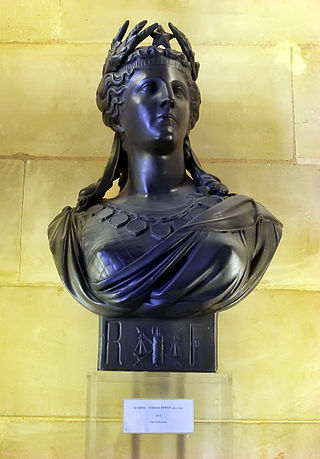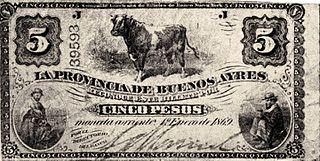
The Mexican peso is the currency of Mexico. Modern peso and dollar currencies have a common origin in the 16th–19th century Spanish dollar, most continuing to use its sign, "$".

The Phrygian cap or liberty cap is a soft conical cap with the apex bent over, associated in antiquity with several peoples in Eastern Europe and Anatolia, including the Persians, the Medes and the Scythians, as well as in the Balkans, Dacia, Thrace and in Phrygia, where the name originated. The oldest depiction of the Phrygian cap is from Persepolis in Iran.

Marianne has been the national personification of the French Republic since the French Revolution, as a personification of liberty, equality, fraternity and reason, as well as a portrayal of the Goddess of Liberty.
The peso is the currency of Argentina since 1992, identified within Argentina by the symbol $ preceding the amount in the same way as many countries using peso or dollar currencies. It is subdivided into 100 centavos, but due to rapid inflation, coins with a face value below one peso are now rarely used. Its ISO 4217 code is ARS. It replaced the austral at a rate of 10,000 australes to one peso.
The Colombian peso is the currency of Colombia. Its ISO 4217 code is COP. The official peso symbol is $, with Col$. also being used to distinguish it from other peso- and dollar-denominated currencies.
Peso dominicano has been the name of the currency of the Dominican Republic since 2010. Its symbol is "$", with "RD$" used when distinction from other pesos is required; its ISO 4217 code is "DOP". Each peso is divided into 100 centavos ("cents"), for which the ¢ symbol is used. With exception of the United States dollar, it is the only currency that is legal tender in the Dominican Republic for all monetary transactions, whether public or private.
The boliviano is the currency of Bolivia. It is divided into 100 cents or centavos in Spanish. Boliviano was also the name of the currency of Bolivia between 1864 and 1963. From April 2018, the manager of the Central Bank of Bolivia, Pablo Ramos, announced the introduction of the new family of banknotes of the Plurinational State of Bolivia, started with the 10 Bs note, and then gradually arrived to introduce the 200 Bs note, presented in April 2019. The new family of banknotes of the Plurinational State received several awards such as "the best banknotes in Latin America", was highlighted by its security measures, its aesthetics and its inclusion of prominent figures in Bolivian history, being among those who awarded the "Latin American High Security Printing Press Conference".
Uruguayan peso has been a name of the Uruguayan currency since Uruguay's settlement by Europeans. The present currency, the peso uruguayo was adopted in 1993 and is subdivided into 100 centésimos, although centésimos are not currently in use.
The austral was the currency of Argentina between June 15, 1985, and December 31, 1991. It was divided into 100 centavos. The symbol was an uppercase A with an extra horizontal line, (₳). This symbol appeared on all coins issued in this currency, to distinguish them from earlier currencies.
The peso argentino was the currency of Argentina between June 1, 1983, and June 14, 1985. It was subdivided into 100 centavos. The symbol was $a. The ISO 4217 code was ARP.
The peso moneda nacional was the currency of Argentina from 5 November 1881 to 1 January 1970, the date in which the peso ley 18.188 was issued to the Argentine public. It was subdivided into 100 centavos, with the argentino worth 5 pesos. The peso was introduced to replace the Argentine peso moneda corriente at a rate of $+m⁄c 25 = m$n 1.

The peso moneda corriente was a non-convertible Argentine paper currency which circulated between 9 January 1826, and 4 November 1881. It was worth eight reales. Its symbol was $m/c. It was also known as the peso papel.

The Casa de Moneda de la República Argentina is the Argentine mint, controlled by the Argentine government and administratively subordinated to the Ministry of Economy. It was established in 1875 as "Casa de Moneda de la Nación".

The Museo Casa de Moneda is a numismatics museum located in La Candelaria neighborhood of Bogotá, Colombia. It is managed by the Bank of the Republic of Colombia and used to display its numismatic collection that is composed by around 18,600 objects that include artwork, banknotes, bonds, coins, derivatives, medals, negotiable instruments, and printing instruments from various periods and regions of the world.

The Pirámide de Mayo, located at the hub of the Plaza de Mayo, is the oldest national monument in the City of Buenos Aires. Its construction was ordered in 1811 by the Primera Junta to celebrate the first anniversary of the May Revolution. It was renovated in 1856, under the direction of Prilidiano Pueyrredón. In 1912, after having undergone many modifications, it was moved 63 metres to the east, with the idea that a much larger monument would eventually be constructed around it.

The Efígie da República is used as a national personification, both in Brazil and in Portugal, symbolizing the Republic.

This is an outline of Uruguay's monetary history. For the present currency of Uruguay, see Uruguayan peso.
There are many landmarks in Buenos Aires, Argentina some of which are of considerable historical or artistic interest.

Hispania is the national personification of Spain.

José Fioravanti was a prolific Argentine sculptor known for the many civic monuments he created.
























